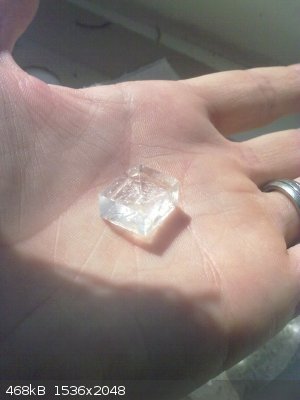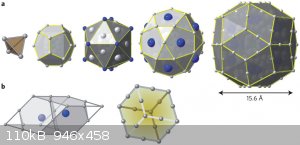Fantasma4500
International Hazard
    
Posts: 1677
Registered: 12-12-2012
Location: Dysrope (aka europe)
Member Is Offline
Mood: dangerously practical
|
|
Spheric crystal appearance??
crystals, theyre fascinating as hell.. many gems are cut to become more round, but thats not the natural crystal shape.. before discovering the
amazingly accurate shape of seemingly very pure sodium chlorate, grown through 5V40A electrolysis with excess salt (physically in excess,
undissolvable excess), titanium-MMO i got amazed over the shape.. however to the point, is there any actual crystal which naturally forms a discoid,
spherical or round crystal, or just even towards that?? if there is a perfect square crystal, then there must be a round crystal as well, and there
should be more than just one.. right??
in short: what chemical compound forms round crystals upon crystallization?

|
|
|
Tdep
National Hazard
   
Posts: 516
Registered: 31-1-2013
Location: Laser broken since Feb 2020 lol
Member Is Offline
Mood: PhD is done! It isn't good but it's over lol
|
|
No there's not going to be a round crystal from my understanding of it.
Crystals occur because the minerals take on a particular shape, like in sodium chloride where each sodium ion is surrounded by 6 Cl ions. Minerals
have different unit cells (the smallest repeating unit) mainly depending on the co-ordination number of the ions, which is basically determined by
ionic size and charge. The mineral likes to stack the ions uniformly and in the most efficient way possible.
There is no spherical unit cell (and hence no spherical crystals) because you cannot tessellate spheres. The co-ordination between ions is not good,
and you're wasting space which is energetically completely unfavorable. You can only make unit cells out of stackable shapes, like hexagons or cubes
or triangles (silica tetrahedra area a big thing) but circles and spheres don't stack, so there are no cylinder or spherical crystals.
|
|
|
aga
Forum Drunkard
    
Posts: 7030
Registered: 25-3-2014
Member Is Offline
|
|
There's Hexagonal ones, such as bassalt.
https://en.wikipedia.org/wiki/Giant's_Causeway
|
|
|
j_sum1
Administrator
       
Posts: 6220
Registered: 4-10-2014
Location: Unmoved
Member Is Offline
Mood: Organised
|
|
A couple of things in confusion here. There is the atomic arrangement and the macroscopic shape.
The term crystal refers to there being a regular, ordered, repeating atomic arrangement in a solid state. As such it is a term that refers to the
micro (ok, nano) scale. There is no reason why a crystal cannot have any particular shape. Cylinders and spheres included. In jewellery, crystals
are routinely cut to particular visually appealing shapes. Jet turbine blades are made from a single crystal. Cylindrical single crystals of Si are
the starting point for manufacture of chips. And you can even bend a crystal so that the orientation of the crystal structure is different at
different points. Still a crystal. (Consider a sheet of galvanised roofing iron with large zinc crystals on it. You can bend and form the steel and
the zinc bends with it. It is still a crystal even though its directional properties are different at different locations.) So, in a sense, the term
crystal is completely independent of macroscopic shape.
However, the atomic structure and the mechanism of formation of crystals leads to a couple of important properties.
The first is cleavage planes. Most crystals are not equally strong in all directions. They have planes on which they typucally fracture and they
form flat faces.
Similarly, crystal growth is not uniform in all directions as the crystals are forming.
These two properties lead to the characteristic macroscopic shapes of crystals. That is the lovely shapes that we associate in crystalline
structures.
So, while it is technically possible to have a crystal in any shape you like, crystals that form naturally will possess certain macroscopic shapes.
Spheres and cylinders are not among them.
|
|
|
Fantasma4500
International Hazard
    
Posts: 1677
Registered: 12-12-2012
Location: Dysrope (aka europe)
Member Is Offline
Mood: dangerously practical
|
|
well only thing that came closest i saw was a crystal which appears more or less flat, but yet circular, as it moves from the core, and outwards, but
its not spherical.. i guess, yes.. it would be very rare to see a crystal that is entirely spherical, but it must happen at SOME point, although it
does seem from what you say, Tdep which makes a lot of sense, that they seek to use the space as much as possible, which circles arent good for
really, at least the roundness will only be in one dimension, like a cylinder
but if we were to have a naturally formed crystal that was spherical, i guess a blob of mercury frozen down could do, although its not
crystal-crystal, like when you let gallium harden, induce a small piece of gallium then drag it out, and gallium will have formed a flat-edged crystal
around the seed crystal -- that kind of crystal, of course.. thanks for the information!
|
|
|
Sedit
International Hazard
    
Posts: 1939
Registered: 23-11-2008
Member Is Offline
Mood: Manic Expressive
|
|
Quazicrystals perhaps?

Knowledge is useless to useless people...
"I see a lot of patterns in our behavior as a nation that parallel a lot of other historical processes. The fall of Rome, the fall of Germany — the
fall of the ruling country, the people who think they can do whatever they want without anybody else's consent. I've seen this story
before."~Maynard James Keenan
|
|
|
PHILOU Zrealone
International Hazard
    
Posts: 2893
Registered: 20-5-2002
Location: Brussel
Member Is Offline
Mood: Bis-diazo-dinitro-hydroquinonic
|
|
natural garnets often crystallize as globulous facetted round volumes.
Just a parenthese about NaClO3 the cristals may be levogyre or dextrogyre...so watching with polarized glasses may allow you to separate the two
forms.
This is paradoxal because NaClO3 isn't chiral, but the crystallisation induces it randomly.
[Edited on 29-8-2015 by PHILOU Zrealone]
PH Z (PHILOU Zrealone)
"Physic is all what never works; Chemistry is all what stinks and explodes!"-"Life that deadly disease, sexually transmitted."(W.Allen)
|
|
|
DeIonizedPlasma
Harmless

Posts: 21
Registered: 28-9-2014
Member Is Offline
Mood: No Mood
|
|
I recall seeing a picture on a website by an organic chemist who crystallized an organic compound in a RBF that formed hundreds of seemingly perfectly
circular crystalline structures. I am not sure if this is the same, but they do look quite nice.
http://labphoto.tumblr.com/post/99584521333/yesterday-i-have...
|
|
|
Fantasma4500
International Hazard
    
Posts: 1677
Registered: 12-12-2012
Location: Dysrope (aka europe)
Member Is Offline
Mood: dangerously practical
|
|
we are coming close, however if we could find a compound that would have 360 edges, it could possibly appear as a perfect circle, and from thereon it
would maybe be possible to also become a sphere.. the natural garnets do come sort of close, but they arent entirely spherical..
the picture of the RBF crystals seems to come very close, although it isnt speherical, but still does form a very nice seemingly perfect circle.. nice
pictures
but straight edges would seem as the most logical for a crystal to put itself in, compactness wise, crystals arent creative they just follow laws of
physics
|
|
|